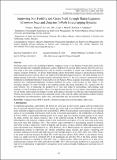| dc.description.abstract | Declining crops yield in the smallholder farmers cropping systems of sub-Saharan African (SSA) present the
need to develop more sustainable production systems. Depletion of essential plant nutrients from the soils have
been cited as the main contributing factors due to continues cultivation of cereal crops without application of
organic/ inorganic fertilizers. Of all the plant nutrients, reports showed that nitrogen is among the most limiting
plant nutrient as it plays crucial roles in the plant growth and physiological processes. The most efficient way of
adding nitrogen to the soils is through inorganic amendments. However, this is an expensive method and creates
bottleneck to smallholder farmers in most countries of sub-Saharan Africa. Legumes are potential sources of plant
nutrients that complement/supplement inorganic fertilizers for cereal crops because of their ability to fix
biological nitrogen (N) when included to the cropping systems. By fixing atmospheric N2, legumes offer the
most effective way of increasing the productivity of poor soils either in monoculture, intercropping, crop
rotations, or mixed cropping systems. This review paper discuses the role of cereal legume intercropping systems
on soil fertility improvement, its impact on weeds, pests, diseases and water use efficiency, the biological nitrogen
fixation, the amounts of N transferred to associated cereal crops, nutrients uptake and partition, legume biomass
decomposition and mineralization, grain yields, land equivalent ratio and economic benefits. | en_US |


